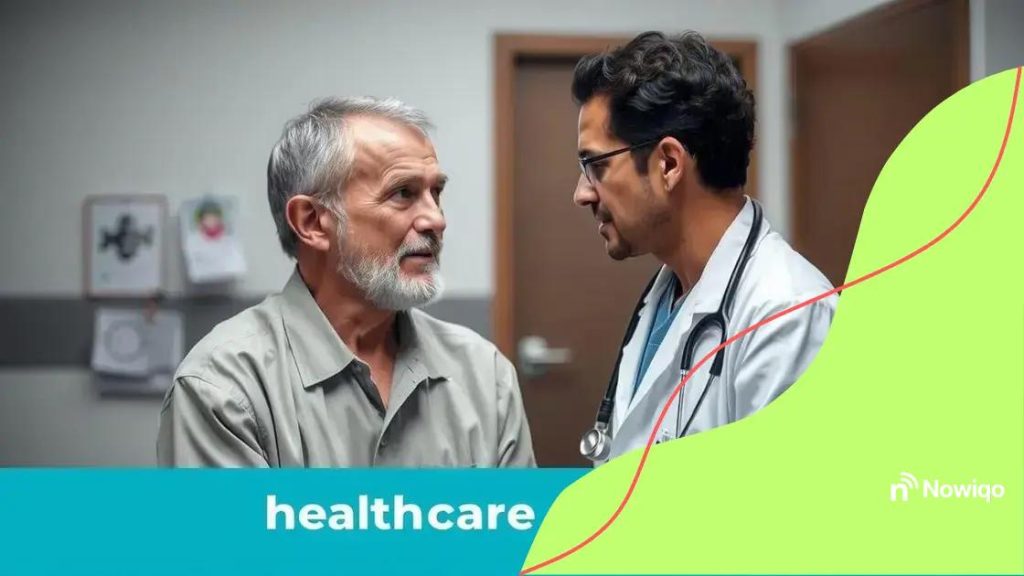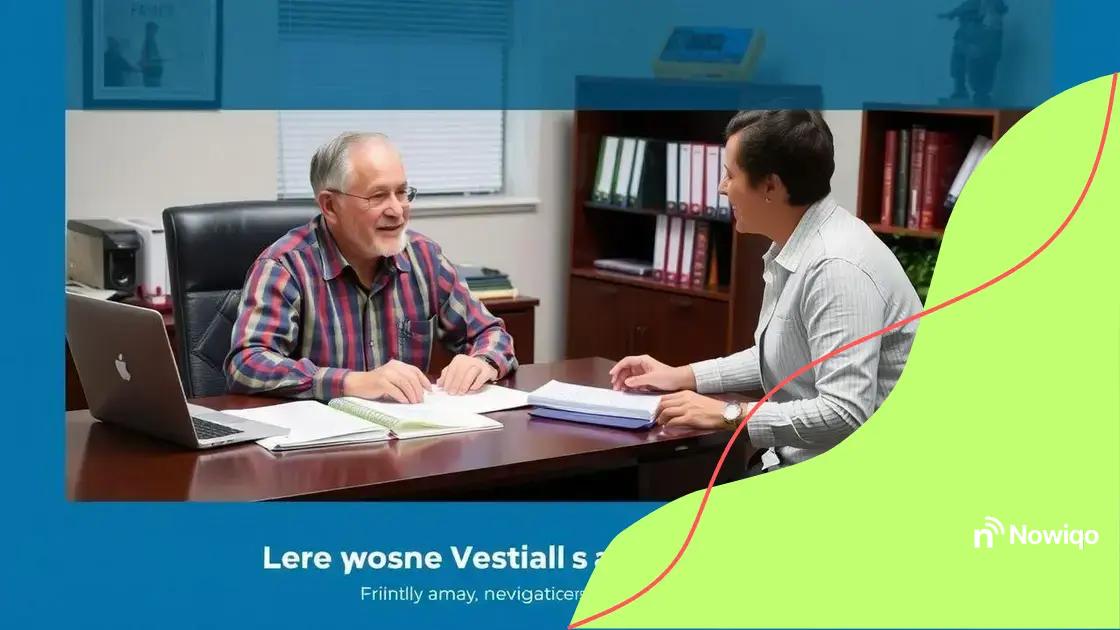Veterans healthcare access: what you need to know

Anúncios
Veterans healthcare access includes a range of services like medical care, mental health support, and community resources, all aimed at helping veterans effectively navigate the healthcare system and improve their overall wellbeing.
Veterans healthcare access plays a vital role in the well-being of those who have served our country. Have you ever wondered how different systems and resources work together to support veterans? Let’s take a closer look at this important topic.
Anúncios
Understanding veterans healthcare systems
Understanding veterans healthcare systems is essential for ensuring that our veterans receive the care they deserve. The healthcare landscape for veterans includes various benefits and services tailored specifically for those who have served in the military.
Veterans can access care through the Department of Veterans Affairs (VA) and other facilities. Each state also has programs aimed at addressing the specific needs of veterans, often through outpatient and fully integrated health systems. These resources can often appear complex, but they are in place to support veterans’ health and improve their quality of life.
Types of veterans healthcare services
There are multiple avenues to explore when navigating veterans healthcare systems. Understanding these services can empower veterans to make informed decisions regarding their care.
Anúncios
- Primary care services: These are essential for managing routine and preventive healthcare needs.
- Mental health support: Access to therapists and counselors specifically trained to help veterans.
- Specialized health issues: Services addressing unique conditions such as PTSD or combat-related injuries.
- Rehabilitation and therapy: Programs designed to assist veterans in recovering from injuries or adapting to changes in their health.
Veterans also have access to additional resources such as telehealth services, which can greatly enhance their experience in receiving care from their homes. Veterans healthcare systems emphasize personalized support aimed at meeting individual needs.
Moreover, understanding eligibility is crucial. Each veteran may qualify for different levels of attention based on their service records and health requirements. By staying informed about the options available, veterans can actively engage in their healthcare journey.
Overall, the integration of these systems is designed not just to provide care but also to empower veterans with the knowledge and resources they need for improved health outcomes.
Challenges faced by veterans accessing healthcare
Challenges faced by veterans accessing healthcare can vary widely, affecting many individuals differently. It is important to recognize these hurdles to better understand how they impact the lives of our veterans. Many veterans may feel overwhelmed when trying to navigate the complex systems in place.
One of the main challenges is the confusion regarding eligibility. Veterans may not know what services they qualify for, leading to frustration and a lack of access to necessary resources. Often, policies are not clearly communicated, which can create additional barriers.
Common barriers to healthcare access
Aside from eligibility issues, several systemic barriers can hinder veterans from receiving the care they need.
- Long wait times: Many veterans experience extended delays when trying to schedule appointments, affecting timely healthcare.
- Limited availability of specialists: In some areas, veterans may not have easy access to specialists who understand their unique health issues.
- Geographical challenges: Rural veterans may struggle to reach healthcare facilities, making travel a significant obstacle.
- Mental health stigma: Some veterans may hesitate to seek mental health services due to societal stigma or misconceptions.
Additionally, a lack of technological familiarity can impede the use of telehealth services, which have become increasingly important for many veterans. The transition to online platforms often leaves some feeling uncomfortable or lost, making access more challenging.
Furthermore, the complexity of navigating various benefits and pathways to care can dissuade veterans from seeking help. It’s crucial for veterans to be informed about available resources and to receive clear guidance on how to access them.
Overcoming these challenges requires a multi-faceted approach, including increased awareness and improved support systems to help veterans access the healthcare they deserve.
How to navigate the benefits available

How to navigate the benefits available to veterans can often seem like a daunting task. However, there are specific steps and resources that can make this process easier. It’s essential for veterans to feel empowered and informed about their options.
First, veterans should begin by understanding the types of benefits available to them. These can include healthcare services, disability compensation, education benefits, and housing assistance. Each category has distinct eligibility requirements and application processes, so it’s vital to take the time to learn about them.
Steps to access veterans benefits
Here are some important steps to consider when navigating benefits:
- Gather necessary documents: Proof of service, medical records, and financial information are often needed.
- Visit the VA website: The VA website provides comprehensive information about benefits and how to apply.
- Contact your local VA office: Local representatives can assist you in understanding your options and completing applications.
- Utilize support organizations: Many non-profits and veteran organizations offer guidance and resources to help veterans.
After learning about the options, it is crucial to take action. Many benefits have specific application deadlines, so submitting documents promptly can lead to quicker assistance. Additionally, veterans should consider reaching out to fellow veterans who have been through the process. They can provide valuable insights and tips based on their experiences.
Another important factor is staying organized. Keeping track of deadlines and documentation can help streamline the process, making it less overwhelming. By taking one step at a time, veterans can navigate the maze of benefits more effectively.
Lastly, always remember that it’s okay to ask for help. Whether through a family member, friend, or professional, support is available, and seeking assistance is a positive step toward ensuring you receive the benefits you deserve.
Role of technology in improving access
Role of technology in improving access to healthcare services for veterans is becoming increasingly vital. Technology has the potential to bridge the gap between veterans and the medical care they require, making it easier for them to access essential services.
Telehealth services have emerged as a key component in this transformation. Through virtual appointments, veterans can consult with doctors from the comfort of their homes, eliminating the need for long trips to healthcare facilities. This is especially beneficial for those living in rural areas where access to healthcare providers may be limited.
Key technological advancements
Several advancements are being utilized to enhance healthcare access for veterans:
- Mobile applications: Various apps allow veterans to manage appointments, access medical records, and communicate directly with healthcare providers.
- Wearable devices: These devices monitor health metrics and can alert healthcare professionals to any concerning changes, ensuring timely intervention.
- Online support groups: Veterans can connect with peers and share experiences, gaining support through online platforms dedicated to mental health.
- AI-powered chatbots: These help answer questions and guide veterans through administrative processes, making it easier to obtain information and services.
Integrating these technologies into healthcare systems is not without challenges. Some veterans may struggle with technology due to age, anxiety, or lack of training. To address this, initiatives are in place to provide training and support to help veterans become comfortable with new tools.
Improving access also requires a shift in healthcare culture to embrace technology. Providers must be willing to adapt and learn new ways to engage with their patients. This cultural shift can ultimately lead to better health outcomes for veterans, as they receive care that is convenient and accessible.
Overall, technology has the potential to significantly enhance the accessibility of healthcare services for veterans, ensuring they receive timely and effective care.
Community resources for veterans healthcare
Community resources for veterans healthcare play a crucial role in supporting veterans on their journey toward better health. Many organizations and programs are dedicated to helping those who served our country access necessary services.
Local community resources offer various services, from healthcare to financial assistance and social support. These resources are essential for veterans who may face challenges when navigating the broader healthcare system.
Types of community resources
Here are some common types of community resources available to veterans:
- Veterans Service Organizations (VSOs): These groups provide assistance with benefits claims, legal services, and support for reintegration into civilian life.
- Support groups: Many communities host peer-led support groups where veterans can share experiences and find camaraderie.
- Healthcare clinics: Community health centers often provide low-cost or free medical care specifically for veterans.
- Employment programs: Programs focused on job training and placement can help veterans transition into the workforce.
In addition to the above, local non-profits often offer services tailored to veterans’ unique needs. These can include counseling, housing assistance, and transportation services to medical appointments.
Another valuable resource is the use of online directories that help veterans identify available services in their areas. These directories can simplify the process of finding the right support, making it easier for veterans to get the help they need.
It’s important for veterans to remain proactive in seeking out these community resources. Engaging with local organizations can connect them with others who understand their experiences and can provide valuable support.
In summary, community resources offer essential support for veterans, ensuring they have access to healthcare, emotional support, and other services that enhance their overall well-being.
FAQ – Frequently Asked Questions about Veterans Healthcare Access
What types of healthcare benefits are available for veterans?
Veterans can access a range of benefits including medical services, mental health support, disability compensation, and education initiatives.
How can technology improve healthcare access for veterans?
Technology can enhance access through telehealth services, mobile apps for managing appointments, and online support groups to connect with peers.
What community resources are available to assist veterans?
Community resources include Veterans Service Organizations, local health clinics, housing assistance programs, and dedicated mental health services.
How can veterans stay informed about their healthcare options?
Veterans should actively seek information through VA resources, local organizations, and peer support, ensuring they understand the available benefits and services.